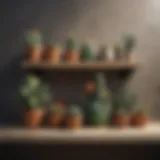Easy-to-Care-for Indoor Plants: A Beginner's Guide to Greenery Bliss
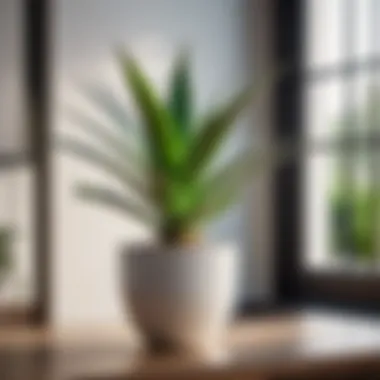

Materials:
- Selection of indoor plants (e.g., succulents, snake plants, pothos)
- Potting soil mix appropriate for chosen plants
- Plant pots with drainage holes
- Watering can or spray bottle
- Fertilizer suitable for indoor plants
DIY Steps:
- Selecting Indoor Plants: Choose plants known for their low-maintenance qualities such as succulents, snake plants, or pothos.
- Potting Soil Mix Preparation: Create a well-draining soil mix by combining potting soil with perlite or sand.
- Planting: Gently remove plants from their nursery pots, loosen the root ball, and place them in new pots filled with the prepared soil mix.
- Watering Routine: Water your plants only when the top layer of soil feels dry to the touch, ensuring not to overwater.
- Placement: Position your plants in locations with adequate sunlight based on their specific light requirements.
- Fertilizing: Feed your plants with a diluted solution of indoor plant fertilizer according to the product instructions.
Technical Aspects:
- Tools: Basic gardening tools like shears, gloves, or trowel
- Timing: Best time to plant indoor plants is during the growing season, usually spring or early summer
- Critical Techniques: Proper watering techniques, understanding light needs, and monitoring for pests or diseases
DIY Project Process:
- Plant Selection and Readiness: Ensure chosen plants are suitable for indoor environments and research their care requirements.
- Soil Preparation and Planting: Mix soil thoroughly, pot plants with care, and ensure adequate drainage holes in pots.
- Watering and Feeding: Establish a consistent watering schedule and incorporate feeding into routine care.
- Lighting and Placement: Strategically place plants near windows or under indoor grow lights to fulfill their light needs.
- Maintenance and Monitoring: Regularly check plants for signs of distress, adjust care as needed, and address any issues promptly.
- Troubleshooting Tips: If plants show wilting or yellowing leaves, reassess watering habits. Pests can be managed with organic solutions like neem oil.
Introduction
Understanding the Benefits of Indoor Plants
Indoor plants play a significant role in improving indoor air quality by absorbing carbon dioxide and releasing oxygen, creating a healthier environment for you and your family. These plants also have the ability to reduce stress, boost mood, and increase productivity, making them essential additions to any home. Furthermore, indoor plants can enhance concentration and promote a sense of well-being, contributing to a more relaxed and peaceful atmosphere.
Research has shown that indoor plants can help reduce fatigue, headaches, and coughs, acting as natural air purifiers by removing harmful toxins from the air. By bringing nature indoors, you can experience the therapeutic effects of greenery, ultimately leading to a happier and healthier lifestyle. Understanding the benefits of indoor plants is essential for beginners embarking on their plant care journey, as it motivates and inspires individuals to nurture their indoor green companions for long-lasting benefits.
Choosing the Right Indoor Plants
In this article, 'Choosing the Right Indoor Plants' plays a pivotal role in guiding beginners towards successfully nurturing indoor greenery. Selecting the appropriate indoor plants is crucial as it sets the foundation for a thriving indoor garden. By understanding the specific needs and characteristics of different houseplants, individuals can choose ones that align with their lifestyle and home environment. This section delves into various categories of indoor plants tailored for beginners, offering valuable insights into plant selection.
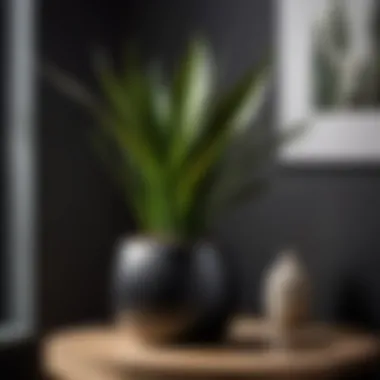

Factors to Consider Before Selecting a Houseplant
Before diving into the world of indoor plants, there are several essential factors to consider. These include assessing the available space in your home, determining the level of natural light exposure different areas receive, understanding your time commitment to plant care, and considering any potential pet or child hazards. By evaluating these aspects, individuals can make informed decisions when choosing the right houseplants for their living space.
Low-Light Tolerant Plants
For areas in the home that receive minimal natural light, low-light tolerant plants are the perfect solution. Popular choices in this category include the Snake Plant, Spider Plant, and Peace Lily. These plants thrive in indirect sunlight, making them ideal for rooms with limited windows or shaded corners. Each plant offers unique benefits, ranging from air purification properties to easy maintenance, enhancing the indoor environment while requiring minimal sunlight.
Snake Plant
The Snake Plant, known for its striking vertical leaves, is highly resilient and requires minimal attention, making it an excellent choice for beginners. Its adaptability to low light conditions and ability to purify indoor air make it a valuable addition to any home. While providing a touch of greenery, the Snake Plant also contributes to a healthier indoor atmosphere.
Spider Plant
With its cascading foliage and air-purifying qualities, the Spider Plant adds a decorative element to any space while requiring little maintenance. Its ability to thrive in indirect sunlight and its safe nature for pets makes it a popular choice among indoor plant enthusiasts. The Spider Plant's resilience and aesthetic appeal make it a versatile and practical option for beginners.
Peace Lily
The Peace Lily, prized for its elegant white blooms and lush green leaves, is a beloved choice for its adaptability to low-light environments and air-purifying abilities. Its unique combination of beauty and functionality makes it a sought-after houseplant for beginners looking to enhance their indoor spaces with a touch of serenity. While enchanting in appearance, the Peace Lily also contributes to creating a peaceful and harmonious atmosphere within the home.
Indirect Light Options
When providing moderate exposure to natural light, plants that thrive in indirect light conditions are suitable choices. Popular options in this category include Pothos, ZZ Plant, and Philodendron. These plants can thrive in areas with filtered sunlight, making them versatile and resilient indoor companions. With distinctive characteristics and benefits, each plant offers homeowners the opportunity to introduce greenery into their living spaces with ease.
Pothos
Renowned for its trailing vines and vibrant foliage, Pothos is a versatile plant that adapts well to indirect sunlight. Its low-maintenance nature and air-purifying properties make it a top choice for beginner plant owners. The Pothos' cascading leaves and hardy disposition add a refreshing touch of green to any room, creating a harmonious indoor environment.
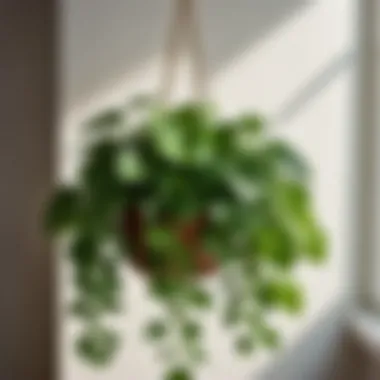

ZZ Plant
Characterized by its glossy, dark green leaves and robust growth, the ZZ Plant thrives in spaces with indirect light and minimal watering requirements. Its unique appearance and resilience against neglect make it an excellent option for individuals venturing into plant care. The ZZ Plant's ability to thrive in various conditions and enhance indoor aesthetics positions it as a valuable addition to beginner-friendly indoor gardens.
Philodendron
Boasting heart-shaped leaves and a climbing nature, Philodendron plants are well-suited for bright, indirect light settings. Their easy-going demeanor and ability to purify the air make them popular choices among beginner plant enthusiasts. With its elegant foliage and manageable care needs, the Philodendron adds a touch of sophistication to indoor spaces, promoting a sense of tranquility and beauty.
Bright Light Loving Plants
For areas in the home that receive ample sunlight, bright light loving plants thrive optimally. Aloe Vera, Rubber Plant, and Fiddle Leaf Fig are amongst the favored choices in this category. These plants thrive in well-lit environments, accentuating their unique features and promoting healthy growth when exposed to adequate sunlight. By incorporating these plants into indoor spaces, individuals can create vibrant and flourishing green sanctuaries.
Aloe Vera
Known for its medicinal properties and succulent leaves, Aloe Vera thrives in bright, sunny locations and requires minimal watering. Its sun-loving nature and air-purifying abilities make it a valuable addition to indoor settings. The Aloe Vera plant not only adds a touch of green to spaces but also serves as a practical and beneficial plant to have on hand for various health and wellness purposes.
Rubber Plant
With its large, glossy leaves and striking appearance, the Rubber Plant flourishes in well-lit areas and adds a dramatic touch to indoor decor. Its sturdy nature and tolerance for bright light conditions make it an appealing choice for beginners seeking a statement plant. The Rubber Plant's ornamental qualities and easy-to-care-for reputation establish it as an excellent companion for those looking to introduce dynamic foliage into their living spaces.
Fiddle Leaf Fig
Admired for its broad, fiddle-shaped leaves and sculptural presence, the Fiddle Leaf Fig thrives in bright, indirect light and requires moderate care. Its elegant silhouette and ability to thrive in well-lit environments make it a favorite among plant enthusiasts. The Fiddle Leaf Fig's iconic presence and refined aesthetic bring a touch of sophistication to indoor settings, elevating the visual appeal of any room.
Caring for Your Indoor Plants
In the realm of indoor plant care, understanding how to properly nurture your green companions is crucial for ensuring their longevity and thriving growth. This section delves into the essential aspects of caring for indoor plants, emphasizing specific elements that are vital for their well-being. One of the key benefits of focusing on caring for your plants is the sense of fulfillment and satisfaction that comes from watching them flourish under your guidance. By tending to their needs diligently, you create a harmonious environment that promotes both your plants' health and your own well-being.
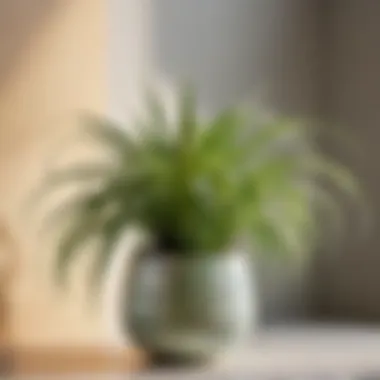

Watering and Light Requirements
Watering and light are two fundamental elements in the care of indoor plants. Adequate watering ensures that your plants receive the necessary hydration to support their physiological processes. It is important to strike a balance between underwatering and overwatering, as both can have detrimental effects on plant health. Additionally, understanding the light requirements of different plant species is crucial for placing them in optimal locations within your home. Some plants thrive in bright, direct sunlight, while others prefer indirect light or low-light conditions. By familiarizing yourself with the specific watering and light needs of your indoor plants, you pave the way for their successful growth and development.
Maintenance Tips for Healthy Growth
Maintaining the overall health and vitality of your indoor plants involves regular monitoring and upkeep. To promote healthy growth, it is essential to remove any dead or yellowing leaves, as they can indicate underlying issues such as overwatering or nutrient deficiencies. Furthermore, periodically dusting the leaves of your plants helps facilitate proper photosynthesis by allowing them to absorb sunlight more efficiently. Implementing a consistent maintenance routine, which includes inspecting your plants for signs of pests or diseases, is key to ensuring they remain robust and resilient.
Common Issues and Troubleshooting
Despite your best efforts, indoor plants may encounter common issues that require prompt attention and resolution. Yellowed leaves, wilting stems, or stunted growth are all signals that something may be amiss in your plant's environment. By conducting a thorough assessment and identifying the possible causes of these issues, such as overwatering, inadequate lighting, or pest infestations, you can take decisive steps to rectify the situation. Utilizing organic pest control methods and adjusting watering and light schedules are effective troubleshooting measures that can help alleviate plant problems and restore their health.
Creating a Green Oasis Indoors
In the realm of indoor aesthetics, the topic of creating a green oasis indoors holds pivotal significance. As we delve into this section of the guide on easy-to-care-for houseplants, the concept of cultivating an indoor oasis goes beyond mere decoration; it touches the essence of elevating everyday living spaces into vibrant sanctuaries of tranquility and well-being. Creating a green oasis indoors involves strategic placement of plants that not only enhance the visual appeal of a room but also contribute to mental and physical health.
When considering the importance of incorporating indoor greenery, one cannot overlook the myriad benefits it brings to the table. Not only do houseplants act as natural air purifiers, but they also emit oxygen and promote a sense of serenity and calm. In today's fast-paced world, having a green oasis indoors provides a much-needed respite from the hustle and bustle of daily life, fostering a rejuvenating environment that promotes relaxation and mindfulness.
Moreover, the process of creating a green oasis indoors requires thoughtful consideration of various elements to ensure a harmonious blend of aesthetics and functionality. Factors such as light exposure, humidity levels, and space optimization play crucial roles in curating a nurturing environment for indoor plants to thrive. By carefully selecting and arranging houseplants according to their light and care requirements, individuals can transform their living spaces into flourishing indoor gardens that uplift the ambiance and overall well-being.
As we emphasize the significance of creating a green oasis indoors, it is essential to highlight the therapeutic aspects of surrounding oneself with lush foliage. Numerous studies have shown the positive impact of indoor plants on mental health, stress reduction, and productivity. By incorporating a variety of plant species that resonate with personal preferences and maintenance capabilities, individuals can tailor their indoor oasis to suit their lifestyle and preferences, enriching their surroundings with nature's vitality and beauty.
Conclusion
In the realm of indoor gardening, the conclusion serves as the pivotal junction where preparation and nurturing harmonize to create a flourishing green space within your abode. Throughout this guide on the best indoor plants for beginners, we have explored the intricacies of selecting, caring for, and enjoying houseplants that require minimal maintenance while bestowing a plethora of benefits upon their caretakers.
As we draw the curtains on this journey, it is imperative to reflect on the overarching significance of our green companions. The conclusion encapsulates the essence of commitment and responsibility that comes with tending to indoor plants. It signifies not just the end of a manual on plant care, but the beginning of a beautiful relationship between individuals and nature within the confines of their homes.
One of the core elements highlighted in this conclusion is the profound impact that indoor plants can have on one's well-being. From purifying the air to reducing stress and increasing productivity, these green allies play a multifaceted role in enhancing the quality of life for beginners and seasoned plant enthusiasts alike. By integrating plants into living spaces, individuals can experience a myriad of health benefits while transforming their homes into tranquil sanctuaries of greenery.
Furthermore, the conclusion underscores the environmental considerations associated with indoor gardening. As we navigate the complexities of modern living, incorporating houseplants into our interiors fosters a deeper connection with the natural world and promotes sustainability. By embracing the simplicity of plant care and cultivating a green oasis indoors, individuals contribute towards a greener, more eco-conscious lifestyle that benefits both themselves and the planet.
In essence, the conclusion of this guide not only signifies the completion of a comprehensive exploration of indoor plants for beginners but also marks the beginning of a journey towards nurturing a thriving indoor garden. It encapsulates the joys, challenges, and rewards of embarking on a botanical adventure within the comfort of one's home, fostering a deeper appreciation for the beauty and resilience of the plant kingdom.
